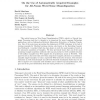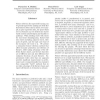470 search results - page 7 / 94 » Using Unknown Word Techniques to Learn Known Words |
LREC
2008
13 years 9 months ago
2008
Deep processing of natural language requires large scale lexical resources that have sufficient coverage at a sufficient level of detail and accuracy (i.e. both recall and precisi...
ACL
2011
12 years 11 months ago
2011
Unsupervised vector-based approaches to semantics can model rich lexical meanings, but they largely fail to capture sentiment information that is central to many word meanings and...
JAIR
2008
13 years 7 months ago
2008
This article focuses on Word Sense Disambiguation (WSD), which is a Natural Language Processing task that is thought to be important for many Language Technology applications, suc...
ICASSP
2010
IEEE
13 years 6 months ago
2010
IEEE
We investigate incremental word learning with few training examples in a Hidden Markov Model (HMM) framework suitable for an interactive learning scenario with little prior knowle...
JMLR
2010
13 years 2 months ago
2010
Feature selection for supervised learning can be greatly improved by making use of the fact that features often come in classes. For example, in gene expression data, the genes wh...


